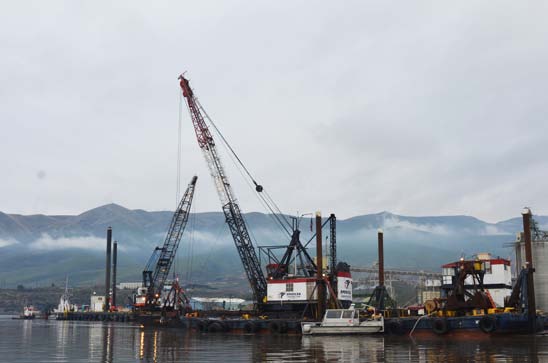forum
library
tutorial
contact

Dredging Planned for
Lower Snake and Clearwater
by Eric Barker
Lewiston Tribune, December 22, 2022
|
the film forum library tutorial contact |

|
Dredging Planned for
by Eric Barker
|
Each year, sediment flushed from mountains in central Idaho and parts of northeastern Oregon
and southeastern Washington, is carried downstream as part of a natural process.
 A Vancouver, Wash., company will begin dredging the lower Snake and Clearwater rivers next month in an effort to maintain the navigation channel that makes the rivers accessible to large commercial vessels and connects the Lewiston-Clarkston Valley to ports on the Columbia River.
A Vancouver, Wash., company will begin dredging the lower Snake and Clearwater rivers next month in an effort to maintain the navigation channel that makes the rivers accessible to large commercial vessels and connects the Lewiston-Clarkston Valley to ports on the Columbia River.
HME Construction Inc. will remove about 258,000 cubic yards of accumulated sediment from the channel under a $5.8 million contract from the Army Corps of Engineers. The company will also remove sediment below the navigation lock of Ice Harbor dam near the Tri-Cities and likely perform work for the ports of Lewiston and Clarkston.
The Corps is authorized by Congress to maintain the channel at a depth of 14 feet and width of 250 feet. It and the four dams on the lower Snake River make tug-and-barge transportation of commodities like wheat between the Tri-Cities and Lewiston possible.
The channel was last dredged in 2015. According to an environmental assessment completed by the Corps, the channel at the confluence of the two rivers is only 9 feet deep in places and there are some places in front of the ports that are about 4 feet deep.
Each year, sediment flushed from mountains in central Idaho and parts of northeastern Oregon and southeastern Washington, is carried downstream as part of a natural process. But much of that sediment, mostly sand and silt, drops out when the rivers transition into slackwater reservoirs created by the four lower Snake River dams. If it's not removed, the channel becomes too shallow for the safe and efficient movement of tug-and-barge tows that carry wheat from Idaho and Washington to the Port of Portland and the cruise boats that call on the ports of Lewiston and Clarkston.
The channel has been dredged about every seven years in the recent past. Previous work to remove sediment has spawned lawsuits from the Nez Perce Tribe and environmental groups who charged the work could harm threatened and endangered salmon and steelhead or Pacific lamprey that are not protected under the Endangered Species Act but are in substantial decline. Dredging was not challenged this time around.
The work must occur between Dec. 15 and March 1, a period known as the in-water work window -- so named because few of the protected fish are present at that time.
The company will use a clamshell dredge to scoop sediment from the river bottom. It will be loaded on a barge and disposed of at River Mile 118, about 20 miles downstream of Lewiston and near Blyton Landing, where the river is about 68 feet deep.
Related Sites:
Dredged Material Management Program by ACOE Walla Walla District, 4/30/20
Related Pages:
Snake, Clearwater Dredging Proposed for This Winter by Eric Barker, Lewiston Tribune, 7/22/22
Judge Dismisses Suit Against Snake River Dredging by Laura Berg, NW Fishletter, 3/7/16
Clear Channel: Dredging Projects Preserve Shipping in the Columbia River by Edward Stratton, The Daily Astorian, 9/29/17
Corps Looking for Input into Dredging Plan by Don Patterson, The Chronicle, 9/11/17
Corps Looks to Dredge Lower Snake River this Winter by Matthew Weaver, Capital Press, 6/26/13
learn more on topics covered in the film
see the video
read the script
learn the songs
discussion forum
